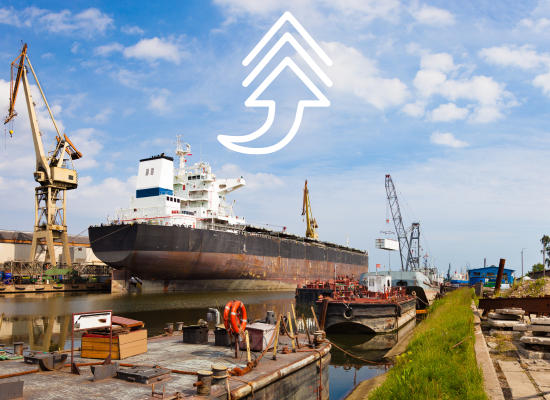
In the ever-evolving landscape of maritime transportation, optimizing the performance and efficiency of older cargo ships is both a challenge and a necessity. With environmental regulations tightening and fuel costs rising, shipowners are increasingly turning to affordable upgrades that can breathe new life into their fleets. From integrating advanced technologies to enhancing operational practices, these strategic enhancements not only extend the operational life of vessels but also improve their competitiveness in the global market.
1. Implementing Air Lubrication Technology
What is Air Lubrication?
Air lubrication technology involves creating a carpet of air bubbles along the hull of the ship. This layer reduces friction between the water and the ship’s hull, which can lead to a noticeable reduction in fuel consumption.
Why Consider It?
- Fuel Efficiency: By reducing drag, air lubrication can lower fuel consumption by about 5-10%. For an old cargo ship, this means significant savings in operational costs.
- Environmental Impact: Less fuel consumption also means reduced greenhouse gas emissions, making your old ship more eco-friendly.
- Cost: Installing an air lubrication system is relatively affordable compared to major structural changes and can be quickly implemented.
Real-World Application
Several older vessels have seen new life with this technology. It’s a practical solution that doesn’t require major reconstruction and can be installed during routine dry dock maintenance.
2. Upgrading to LED Lighting
What’s the Big Deal with LED?
Switching to LED lighting from traditional incandescent or fluorescent lights is one of the simplest yet most effective upgrades for an old ship. LED lights consume significantly less power, last longer, and are more durable against the vibrations and harsh conditions at sea.
Benefits of Switching to LED
- Energy Savings: LEDs consume up to 80% less energy than traditional bulbs, which can lead to considerable savings on energy costs.
- Longevity: LEDs have a lifespan of up to 50,000 hours compared to the 1,000 hours of incandescent bulbs. This means fewer replacements and less maintenance.
- Improved Safety: LEDs emit less heat and reduce the risk of fire, a critical consideration on older vessels.
Installation and Costs
Upgrading to LED lighting is straightforward and can often be done by the ship’s maintenance crew. The initial cost is offset by the long-term savings in energy and maintenance.
3. Hull Cleaning and Coating
Importance of a Clean Hull
The condition of a ship’s hull significantly impacts its performance and fuel efficiency. Over time, biofouling—such as algae, barnacles, and other marine life accumulating on the hull—increases water resistance, leading to higher fuel consumption.
Benefits of Regular Cleaning and Advanced Coatings
- Reduced Drag: A clean hull has reduced resistance, improving speed and lowering fuel consumption.
- Extended Hull Life: Protective coatings prevent corrosion and physical wear, extending the hull’s lifespan.
- Cost-Effectiveness: Regular cleaning and the application of advanced coatings are far less expensive than a major overhaul and can prevent costly repairs in the future.
Practical Tips
Implement a regular schedule for hull cleaning and consider investing in advanced anti-fouling coatings. These coatings not only minimize biofouling but also offer better protection against harsh marine environments.
4. Ballast Water Treatment Systems
What is Ballast Water Management?
Ballast water is used to stabilize ships at sea. Managing it properly is crucial not only for operational efficiency but also to prevent the spread of invasive marine species, which is a growing environmental concern.
Advantages of Updated Systems
- Regulatory Compliance: New international regulations require ships to manage their ballast water to avoid environmental contamination. Installing a modern treatment system ensures compliance and avoids fines.
- Improved Efficiency: Modern systems are more efficient, using less energy and requiring less maintenance than older ones.
- Enhanced Ship Value: An updated ballast water treatment system increases the ship’s resale value and marketability.
Considerations for Upgrade
Choose a system that fits the specific needs of your ship, considering factors like capacity, energy consumption, and ease of installation. Although the initial cost can be significant, the long-term benefits of regulatory compliance and enhanced operational efficiency make it a wise investment.
5. Engine Tune-Up and Modernization
Why Focus on the Engine?
The engine is the heart of any ship, and its efficiency directly impacts fuel consumption and operational costs. Over time, engines can become less efficient due to wear and tear, outdated technology, or poor maintenance.
Benefits of Engine Tune-Up
- Increased Efficiency: Regular tune-ups ensure that the engine operates at peak efficiency, reducing fuel consumption and emissions.
- Reduced Breakdowns: Addressing minor issues during routine maintenance can prevent costly, major repairs in the future.
- Longevity: Properly maintained engines last longer, delaying the need for expensive replacements.
Modernization Options
Consider retrofitting older engines with modern fuel injection systems or control technologies that optimize fuel consumption and reduce emissions. These updates can be more cost-effective than replacing an entire engine.
6. Digital Navigation and Automation Upgrades
The Role of Modern Navigation
Upgrading to advanced digital navigation systems can significantly enhance the safety and efficiency of ship operations. These systems provide accurate real-time data, helping to optimize routes and reduce travel time.
Benefits of Automation
- Increased Safety: Advanced navigation systems reduce human error, a leading cause of maritime accidents.
- Fuel Efficiency: Optimal routing means shorter travel times and reduced fuel consumption.
- Regulatory Compliance: Modern systems ensure compliance with international maritime regulations.
Implementation
Upgrading to a modern electronic chart display and information system (ECDIS) or installing automated navigational tools like autopilots and GPS tracking is usually straightforward. These systems can be integrated with existing equipment, minimizing the need for extensive modifications.
7. Energy Management Systems
Overview of Energy Management
Implementing an Energy Management System (EMS) can provide a comprehensive approach to monitoring and optimizing energy usage on board. These systems leverage sensors and software to track energy consumption across various ship operations, from propulsion to auxiliary services.
Benefits of an EMS
- Optimized Energy Use: By monitoring real-time data, an EMS can suggest adjustments to reduce energy waste, such as optimizing HVAC settings or adjusting speed.
- Cost Savings: Reduced energy consumption directly translates to lower fuel costs.
- Environmental Impact: Decreasing energy usage also means reduced emissions, helping ships meet stricter environmental standards.
How to Implement
Installation of an EMS typically involves integrating software with existing hardware, but it’s scalable depending on the ship’s needs. It’s a strategic investment that pays dividends in both operational efficiency and compliance with environmental regulations.
8. Ventilation System Upgrades
Importance of Effective Ventilation
Good ventilation is crucial for maintaining air quality and controlling temperatures within a ship. Upgrading ventilation systems can improve crew comfort, protect cargo, and reduce the energy costs associated with heating and cooling.
Advantages of Ventilation Upgrades
- Improved Air Quality: Enhanced ventilation systems help remove contaminants and manage humidity, which is especially important for ships carrying sensitive cargo.
- Energy Efficiency: Modern ventilation systems are more efficient and can be integrated with an EMS to optimize energy use.
- Crew Health and Morale: Better air quality and temperature control contribute to a healthier and more comfortable environment for the crew.
Implementation Tips
Upgrading to a high-efficiency ventilation system may involve replacing fans, ducts, and controls. While this requires upfront investment, the benefits in energy savings and improved environmental conditions on board make it a worthwhile upgrade.
Implementing cost-effective upgrades like energy management systems and improved ventilation, along with other practical enhancements, allows shipowners to significantly boost the efficiency and performance of their aging cargo ships. These investments not only ensure compliance with modern environmental and safety standards but also enhance overall operational efficacy, proving that even old ships can sail efficiently into the future with the right modifications.
Additional References
- International Maritime Organization (IMO) – The IMO website provides comprehensive details on regulations and guidelines for energy efficiency in the maritime sector. You can explore sections related to the Energy Efficiency Design Index (EEDI) and the Ship Energy Efficiency Management Plan (SEEMP). Here is the link to the IMO’s portal: International Maritime Organization
- United States Environmental Protection Agency (EPA) – The EPA offers resources on environmental compliance for marine vessels, including information on pollution prevention and energy management strategies. Check their maritime sector regulations and guidelines here: EPA – Maritime Sector
- Maritime and Port Authority of Singapore (MPA) – Known for its progressive maritime policies, the MPA’s website might offer insights into best practices for energy management in shipping. They often have pilot programs and studies on enhancing ship efficiency. Visit their site here: Maritime and Port Authority of Singapore


